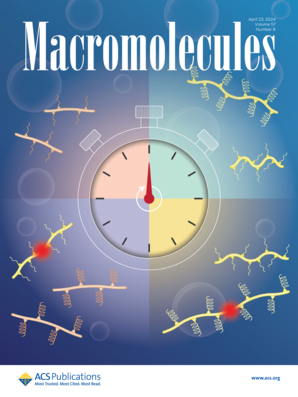氧化三烷基胺修饰的铂聚合物探针的简易合成
IF 5.1
1区 化学
Q1 POLYMER SCIENCE
引用次数: 0
摘要
质量细胞术是一种强大的、高通量的单细胞分析技术,它使用金属标记的抗体,通过电感耦合等离子体飞行时间质谱法检测。目前的试剂使用金属螯合聚合物(MCPs)来处理硬金属离子,但扩展到软金属离子可以显著改善多路复用。然而,高非特异性结合和水溶性差一直是聚合物试剂面临的挑战,软金属离子的螯合剂。为了解决这个问题,我们通过聚(五氟苯基丙烯酸酯)与赖氨酸基DPA螯合剂反应,合成了一种具有二聚胺(DPA)悬垂基团的聚丙烯酰胺聚合物。为了提高Pt2+负载聚乳酸(DPA)的水溶性,我们用氧化三烷基胺(TAAO)分子修饰DPA单元。用谷胱甘肽进一步处理以取代Pt-Cl键得到的聚合物具有增强的水溶性和与外周血单核细胞的低非特异性结合。我们还通过可逆加成-破碎链转移聚合(RAFT)法制备了聚甲基丙烯酸二甲胺乙酯聚合后改性的水溶性TAAO聚合物。氧化反应同时裂解了三硫代碳酸盐端基,并引入了TAAO官能团。所得到的聚taao通过胺端基与聚(DPA)偶联,产生高可溶性聚合物,即使没有谷胱甘肽修饰。用聚taao修饰的铂聚合物在细胞计数中显示出超低的非特异性结合。将聚taao修饰的Pt探针与抗cd20抗体偶联,用于标记外周血单个核细胞。该探针证明了与商用Maxpar试剂相当的有效细胞群体鉴定。这项工作推进了两性离子材料在生物领域的应用,并开发了用于下一代细胞计数试剂的新型MCPs。本文章由计算机程序翻译,如有差异,请以英文原文为准。
Facile Synthesis of Trialkylamine Oxide-Modified Platinum Polymer Probes for Mass Cytometry
Mass cytometry is a powerful, high-throughput single-cell analysis technique that uses metal-tagged antibodies detected via inductively coupled plasma time-of-flight mass spectrometry. Current reagents use metal-chelating polymers (MCPs) for hard metal ions, but expanding to soft metal ions could significantly improve multiplexing. However, high nonspecific binding and poor water solubility have been challenges for polymer reagents, with chelators for soft metal ions. To address this, we synthesized a polyacrylamide polymer with dipicolylamine (DPA) pendant groups by reacting poly(pentafluorophenyl acrylate) with a lysine-based DPA chelator. To enhance the water solubility of Pt2+-loaded poly(DPA), we modified DPA units with trialkylamine amine oxide (TAAO) molecules. Further treatment with glutathione to displace the Pt–Cl bond yielded polymers with enhanced water solubility and low nonspecific binding to peripheral blood mononuclear cells in mass cytometry analyses. We also prepared a water-soluble TAAO polymer through postpolymerization modification of poly(dimethylaminoethyl methacrylate), synthesized via reversible addition–fragmentation chain transfer polymerization (RAFT). The oxidation reaction simultaneously cleaved the trithiocarbonate end group and introduced the TAAO functionality. The resulting polyTAAO was conjugated to poly(DPA) through an amine end group, producing a highly soluble polymer, even without glutathione modification. Pt polymers modified with polyTAAO exhibited ultralow nonspecific binding in mass cytometry. A polyTAAO-modified Pt probe was conjugated to an anti-CD20 antibody and used for labeling peripheral blood mononuclear cells. This probe demonstrated effective cell population identification comparable to that of commercial Maxpar reagents. This work advances zwitterionic materials for biological applications and develops novel MCPs for next-generation mass cytometry reagents.
求助全文
通过发布文献求助,成功后即可免费获取论文全文。
去求助
来源期刊

Macromolecules
工程技术-高分子科学
CiteScore
9.30
自引率
16.40%
发文量
942
审稿时长
2 months
期刊介绍:
Macromolecules publishes original, fundamental, and impactful research on all aspects of polymer science. Topics of interest include synthesis (e.g., controlled polymerizations, polymerization catalysis, post polymerization modification, new monomer structures and polymer architectures, and polymerization mechanisms/kinetics analysis); phase behavior, thermodynamics, dynamic, and ordering/disordering phenomena (e.g., self-assembly, gelation, crystallization, solution/melt/solid-state characteristics); structure and properties (e.g., mechanical and rheological properties, surface/interfacial characteristics, electronic and transport properties); new state of the art characterization (e.g., spectroscopy, scattering, microscopy, rheology), simulation (e.g., Monte Carlo, molecular dynamics, multi-scale/coarse-grained modeling), and theoretical methods. Renewable/sustainable polymers, polymer networks, responsive polymers, electro-, magneto- and opto-active macromolecules, inorganic polymers, charge-transporting polymers (ion-containing, semiconducting, and conducting), nanostructured polymers, and polymer composites are also of interest. Typical papers published in Macromolecules showcase important and innovative concepts, experimental methods/observations, and theoretical/computational approaches that demonstrate a fundamental advance in the understanding of polymers.
 求助内容:
求助内容: 应助结果提醒方式:
应助结果提醒方式:


